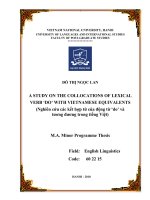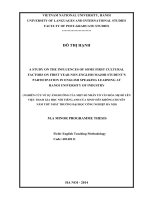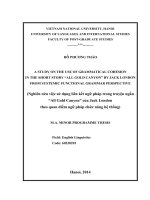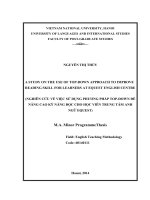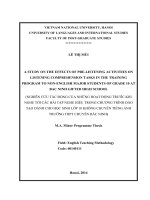A study on the collocations of lexical verb do with Vietnamese equivalents
Bạn đang xem bản rút gọn của tài liệu. Xem và tải ngay bản đầy đủ của tài liệu tại đây (367.26 KB, 11 trang )
A study on the collocations of lexical verb
"do" with Vietnamese equivalents
Đỗ Thị Ngọc Lan
Trường Đại học Ngoại Ngữ
Luận văn ThS. Chuyên ngành: English Linguistics; Mã số: 60 22 15
Người hướng dẫn: Dr. Trần Xuân Điệp
Năm bảo vệ: 2010
Abstract: Although collocations have been studied and viewed from different angles by
numerous scholars, it is still an interesting topic which attracts people’s interest. This study
investigates the collocations of lexical verb ‘do’. The author only focuses on the most
frequent type ‘do + noun phrase’ to analyze.
The study starts with providing/offering some theoretical preliminaries, in which the notion
of collocation with its definition, classification and characteristics is presented. The
researcher also gives some previous studies on collocations. Several previously-conducted
studies are then reviewed briefly.
The main part focuses on analysis of ‘do + noun phrase’ collocations in different contexts, in
which their meanings appeared. Data used in this study are collected from various sources of
textbooks, articles, stories, etc. To obtain one of the objectives of the study is to show the
Vietnamese equivalents of this type of collocations, we take examples in both English and
Vietnamese into consideration.
Finally, some major findings are pointed out. The results show that ‘do + noun phrase’
collocations have different Vietnamese equivalents when they occur in different contexts.
Keywords: Động từ; Ngữ pháp; Tiếng Anh.
Content:
iii
TABLE OF CONTENTS
ACKNOWLEDGEMENTS i
ABSTRACT ii
TABLE OF CONTENTS iii
INTRODUCTION 1
1. Rationale of the study 1
2. Aims of the study 2
3. Scope of the study 2
4. Methods of the study 3
5. Design of the study 3
CHAPTER 1: THEORETICAL BACKGROUNDS AND
LITERATURE REVIEW 5
1.1. English collocation 5
1.1.1. The origin of the word „collocation‟ 5
1.1.2. Definitions of collocation 5
1.1.3. The distinction between free compounds, idioms and collocations 6
1.1.4. Classification of collocation 8
1.1.4.1. In terms of frequent use 8
1.1.4.2. In terms of structure 8
1.1.4.3. In terms of strength 10
iv
1.1.5. Characteristics of collocation 10
1.1.5.1. Collocations are arbitrary 10
1.1.5.2. Collocations are language-specific 11
1.1.5.3. Collocations are not necessarily adjacent 12
1.2. Theory of verbs 13
1.2.1. Definition 13
1.2.2. Classification 13
1.2.2.1. Auxiliary verbs 14
1.2.2.2. Semi-auxiliary verbs 15
1.2.2.3. Lexical verbs (full verbs) 15
1.2.3. The verb „Do‟ in English 15
1.2.3.1. The auxiliary „do‟ 15
1.2.3.2. The lexical „do‟ 16
1.3. Review of some previous studies of collocations 17
CHAPTER 2: COLLOCATIONS OF LEXICAL VERB “DO” WITH
VIETNAMESE EQUIVALENTS 20
2.1. Collocations of lexical verb „do‟ with Vietnamese equivalents 20
2.1.1. Form 21
2.1.2. Meanings 22
2.1.2.1. 'Do' for general ideas 22
2.1.2.2. 'Do' for –ing activities 23
2.1.2.3. „Do‟ for „an activity or a task‟ 24
v
2.1.2.4. „Do‟ for „business‟ 27
2.1.2.5. „Do‟ for „sport‟ 27
2.1.2.6. „Do‟ for „subjects of study‟ 29
2.1.2.7. „Do‟ in other cases 29
2.2. Summary 31
CONCLUSION 33
1. Recapitulation 33
2. Limitations of the study 33
3. Suggestions for further studies 34
REFERENCES 35
SOURCES OF DATA 38
1
PART I
INTRODUCTION
1. Rationale of the study
Vocabulary in general plays an important role in any language as we cannot communicate
without words. British linguist Wilkins (1972:111) once stated “without vocabulary nothing
can be conveyed”. There is a common assumption that the more words a learner knows, the
larger the learner‟s vocabulary knowledge is. However, words are not used alone and
separately but go with each other and depend on each other. Words are combined into phrases.
There are free phrases and fixed phrases. The latter often confuse learners because there are
not any fixed rules for all the combinations. English-as-a-second-language learners often have
difficulties treating fixed phrases in their learning process. That is why many learners cannot
communicate fluently although they know a lot of words. Therefore, the possible
combinations of words or collocations have to be taken into consideration.
Although collocation has become the subject of a linguistic study only recently, it arouses a
growing interest in numerous linguists and is defined in various ways. Accordingly, there is no
exhaustive and uniform definition or categorization of collocation. Therefore, it tends to be
one of the most problematic and important area of vocabulary, especially for second language
learners. Hill (1999:5) goes so far as to suggest: “We are familiar with the concept of
communicative competence, but perhaps we should add the concept of collocational
competence to our thinking”. He also claims that non-native speakers have problems “not
because of faulty grammar but a lack of collocations”. Along with Hill, McCarthy (1990:12)
claims that “collocation deserves to be a central aspect of vocabulary study.” These pieces of
evidence done can show the great importance of collocation in acquisition of a language. The
author would like to investigate the possibility of combining words into fixed expressions.
As mentioned above, phrases are formed by words together. Words in English are classified
into different classes in which verbs have always been one of the most complex classes of
words because verb, or rather, phrasal verb is the central to the structure of the sentence.
2
According to Palmer (1965:1), “learning a language is, to a very large degree, how to operate
the verbal forms, the pattern and the structure of the verb in that language”. There is a question
which need to be answer is that how verbs collocate with other classes of word. A verb can
collocate with a noun, a preposition, an adjective or even another verb. Verb phrases are then
created. Investigating the combinations of verbs must be necessary for improving the students‟
knowledge and lessening their difficulties.
As can be seen from the discussion above, collocation is a big area in linguistics. Due to the
constraints of time, the focus of this study is only on the collocations with the lexical verb
„do‟, a rather special and complex verb in English. Since the research is carried out against the
Vietnamese backgrounds, the corresponding Vietnamese equivalents are also provided. The
research is so entitled “A study on collocations of lexical verb ‘do’ with Vietnamese
equivalents”.
2. Aims of the study
This study aims at investigating the collocations the lexical verb „do‟ in English. This study is
carried out to serve three major purposes:
- To give an overview of the concept of collocation with its main features,
properties and classification.
- To conduct an investigation into the collocations of lexical verb „do‟
- To give Vietnamese equivalents of collocations of „do‟.
In order to get the above-aims, the following questions need to be addressed:
1. What are the meanings of „do‟ in a number of English collocations?
2. What are the Vietnamese equivalents of collocations with lexical verb „do‟ in
corresponding contexts?
3. Scope of the study
This study is confined to the investigation into a very small aspect of vocabulary issue - the
collocations of the lexical verb „do‟ in English. The lexical „do‟ is chosen because „do‟ as an
3
auxiliary verb is limited in use for performing negative and interrogative sentences, or
avoiding repetition or having emphasis function. Meanwhile „do‟ as lexical verb has a number
of meanings when it collocate with other classes of word. In other words, the lexical „do‟ can
be in different collocations with different meanings. „Do‟ as a lexical verb can collocate with a
noun, a preposition, an adjective or an adverb, etc. Within the framework of an M.A. minor
programme thesis, the author has no ambition to cover all the kinds of collocation with the
lexical verb „do‟, but only „do + noun‟ collocations, based on the common assumption that this
is the most frequent collocation of „do‟ and other kinds are less frequent in use and more often
found in dictionaries. Vietnamese equivalents of collocations of „do‟ will be later discussed
through analyzing English – Vietnamese examples in different contexts.
4. Methods of the study
In order to obtain the above-said aims, the study is carried out basically through the
descriptive and qualitative methods. The descriptive method is employed to give in depth and
detailed description of collocations of lexical verb „do‟ in English. The work starts with a
review of existing study results on collocations to provide a better understanding of the topic.
Then different meanings of collocations of lexical verb „do‟ are described, and then examples
are provided to illustrate the description. The qualitative method is used in collecting data.
Collocations with the lexical verb „do‟ will be collected from different sources such as stories,
books, magazines, journals, etc… then analyzed systematically to generalize the uses of these
collocations. In addition, a comparative and contrastive view is used to compare and contrast
collocations of „do‟ and their equivalents in Vietnamese. The method is, overall, both
deductive and inductive.
5. Design of the study
This study is composed of three main parts:
The first part, Introduction, states reasons for choosing the topic, the aims of the study with
the detailed methodology to gain these aims, the scope of the study and the organization of the
study.
4
The second part, Development, includes two chapters:
Chapter 1: features the review of related literature and the theoretical backgrounds for
the study, in which the collocation and the theory of verbs will be discussed. The verb
„do‟ will be also identified in terms of grammatical characteristics in structures related
to „do‟.
Chapter 2: presents and describes concrete cases of collocations with the lexical verb
„do‟ with their Vietnamese equivalents in corresponding contexts.
The third part is the Conclusion summarizing the main ideas discussed in the previous parts,
showing the limitations of the study and providing the suggestions for further studies.
35
REFERENCES
1. Bahns J. (1993), Lexical collocations: a contrastive view, ELT Journal, 47(1), pp. 56-63.
2. Bahns J. & Eldaw M. (1993), Should We Teach EFL Students Collocations? Available at
/>SearchValue_0=EJ465615&ERICExtSearch_SearchType_0=no&accno=EJ465615
3. Benson M., Benson E. & Ilson R. (1986a), Lexicographic Description of English,
Amsterdam/Philadelphia: Benjamins, in Bahns J. (1993), Lexical collocations: a
contrastive view, ELT Journal, 47(1), pp. 56-63.
4. Benson M., Benson E. & Ilson R. (1977), The BBI Combinatory Dictionary of English: A
Guide to Word Combinations, John Benjamin Publishing Company.
5. Benson M., Benson E. & Ilson R. (1986b), The BBI Combinatory Dictionary of English:
A Guide to Word Combinations, Amsterdam/Philadelphia: Benjamins, in Bahns J. (1993),
Lexical collocations: a contrastive view, ELT Journal, 47(1), pp. 56-63.
6. Biber D et al. (1999), Longman Grammar of spoken and written English, Longman.
7. Bolinger D. (1975), Aspects of Language, Harcourt Brave Jovanovich Inc. Press.
8. Chu Thị Phương Vân (2005), The study of the collocation in the English textbook on
Electronics and Telecommunications, M.A thesis, University of languages and
international studies, Vietnam National University, Hanoi.
9. Cruse D.A. (1986), Lexical Semantics, Cambridge: Cambridge University Press.
10. Đào Thị Ngọc Nguyên (2007), Collocations of HARD and HAPPY in English, M.A thesis,
University of languages and international studies, Vietnam National University, Hanoi.
11. Farghal M. & Obiedat H. (1995), Collocations: a neglected variable in EFL, IRAL.
International review of applied linguistics in language teaching, ISSN 0019-042X,
Available at
/>arch_SearchValue_0=EJ521662&ERICExtSearch_SearchType_0=no&accno=EJ521662
36
12. Firth J.R. (1957), Modes of meaning. In J. Firth (Ed.), Papers in linguistics 1934-1951,
London: Oxford University Press.
13. Gairns R. & Redman S. (1986), Working with words: A guide to teaching and learning
vocabulary, Cambridge: Cambridge University Press.
14. Halliday M.A.K (1966), Lexis as a linguistic level, w C.E. Bazell, J.C. Catford, M.A.K.
Halliday & R.H. Robins (Eds.), In memory of J.R. Firth (148-162), London: Longman.
15. Hill J. (1999), Collocational competence, ETP, April 1999 Issue 11.
16. Hornby A.S. (1995), Oxford advanced learner’s dictionary of current English, Oxford:
Oxford University Press.
17. Larson M.L. (1984), Meaning-based translation: A guide to cross-language equivalence,
Lanham, MD: University Press of America, Inc.
18. Lê Thanh Hà (2007), A study on lexical collocations and their implications for English –
Vietnamese translation, M.A thesis, University of languages and international studies,
Vietnam National University, Hanoi.
19. Lewis M. (1997), Implementing the Lexical Approach. The State of ELT And A Way
Forward, Language Teaching Publications.
20. Lewis M. (2000), Teaching collocation: Further Development in the Lexical Approach,
Hove: Language Teaching Publications.
21. McArthur T. (ed). (1992), The Oxford Companion to the English Language, Oxford
University Press.
22. McCarthy M. (1990), Vocabulary, Oxford: Oxford University Press.
23. McCarthy M. & O’Dell F. (2005), English collocations in use, Cambridge University
Press.
24. Palmer F.R. (1965), The English Verb, London: Longman Group Limited.
25. Quirk R. et al. (1972), A Grammar of Contemporary English, Essex: Longman.
37
26. Richards J.C. et al. (1992), Dictionnary of Language Teaching and Applied Linguistics,
Longman Press, Malaysia.
27. Runcie M. (2002), Oxford Collocations Dictionary for Students of English, Oxford
University Press.
28. Sinclair J. (1966), Beginning the Study of Lexis, w C.E. Bazell, J.C. Catford, M.A.K.
Halliday & R.H. Robins (Eds.), In memory of J.R. Firth (148-162), London: Longman.
29. Sinclair J. (1991), Corpus Concordance Collocation, Oxford: Oxford University Press.
30. Trinh F.N. (1995), English collocation: A translator’s problem, Available at
31. Wilkins D.A. (1972), Linguistics in language teaching, Cambridge, MA: MIT Press.

